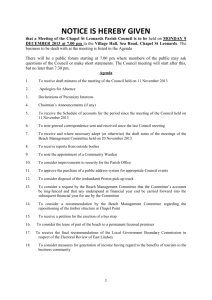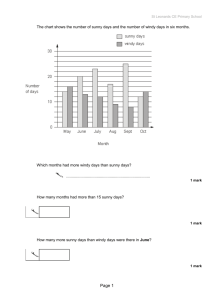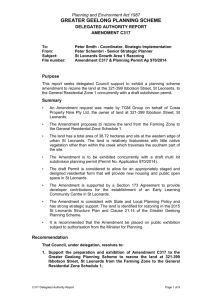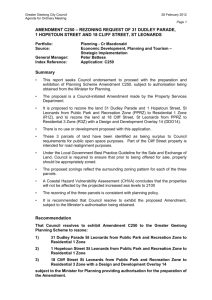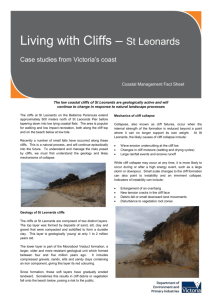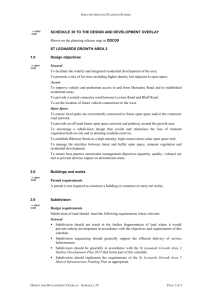St Leonards Structure Plan
advertisement
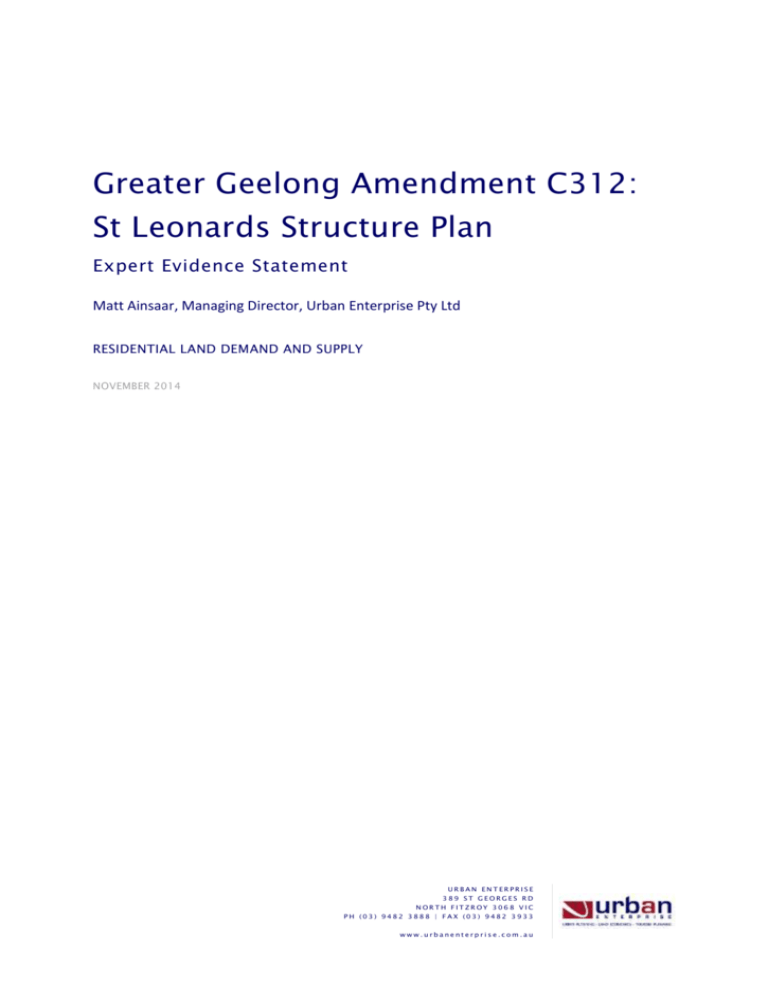
Greater Geelong Amendment C312: St Leonards Structure Plan Expert Evidence Statement Matt Ainsaar, Managing Director, Urban Enterprise Pty Ltd RESIDENTIAL LAND DEMAND AND SUPPLY NOVEMBER 2014 URBAN ENTERPRISE 389 ST GEORGES RD NORTH FITZROY 3068 VIC PH (03) 9482 3888 | FAX (03) 9482 3933 www.urbanenterprise.com.au C ONTENTS 1. QUALIFICATIONS 1 2. ENGAGEMENT 2 3. CONTEXT 3 4. LAND DEMAND AND S UPPLY 6 5. CONCLUSIONS 16 URBAN ENTERPRISE PTY LTD NOVEMBER 2014 1. QUALIFICATIONS 1. My name is Matt Ainsaar and I am the Managing Director and founder of Urban Enterprise Pty Ltd. 2. Urban Enterprise is a firm of urban planners, land economists and tourism planners based in Melbourne. The firm has more than 25 years experience providing consultancy services to all levels of Government and a wide range of private sector organisations in Victoria and in other States of Australia. 3. I am a qualified planner and land economist with more than 35 years experience. 4. Urban Enterprise has a track record of successfully preparing land demand and supply assessments for Councils and landowners. I have appeared as an expert witness at Planning Panel hearings in respect of land demand and supply on many occasions. 5. My educational qualifications and memberships of professional associations include: Bachelor of Town and Regional Planning, University of Melbourne Graduate Diploma of Property, RMIT University Member, Planning Institute of Australia Member, Victorian Planning and Environmental Law Association Associate, Australian Property Institute (Certified Practising Professional). 1 GREATER GEELONG AMENDMENT C312: EXPERT EVIDENCE STAT EMENT ST LEONARDS STRUCTURE PLAN 2. ENGAGEMENT 6. I was instructed by Norton Rose Fulbright on behalf of St Leonards Property Holdings (SLPH) to prepare an expert evidence statement to present at the Planning Panel hearing in relation to this matter. 7. My instructions were to prepare an assessment of the current supply of and demand for residential land in St Leonards and to prepare an expert evidence statement regarding the findings of the assessment. 8. I have reviewed the amendment documentation and other relevant documents and policies. Documentation reviewed includes: St Leonards Structure Plan, City of Greater Geelong, February 2014 (2014 Structure Plan); St Leonards Structure Plan, City of Greater Geelong, September 2006 (2006 Structure Plan); G21 Region Plan, G21 Geelong Region Alliance, 2007; G21 Regional Growth Plan and implementation Plan, Geelong Region Alliance, 2013; G21 Land Supply Monitor, Spatial Economics; and Planning Scheme Amendment C312 documentation; 9. I am familiar with the town of St Leonards and the surrounding area. 10. A copy of the relevant information that is required to accord with the Planning Panels Victoria – Expert Evidence is attached at Appendix A to this report. RESIDENTIAL LAND DEM AND AND SUPPLY NOVEMBER 2014 2 3. C ONTEXT THE AMENDMENT 11. Planning Scheme Amendment C312 to the Greater Geelong Planning Scheme (Amendment C312) proposes to implement the recommendations of the 2014 Structure Plan. 12. Amendment C312 seeks to alter the strategic directions and land use policies for St Leonards moving forward, in line with the new Structure Plan by amending Clause 21.14 of the Planning Scheme. The proposed revised policy: Adds a new objective for St Leonards to “Support the development of Growth Areas 1 and 2 identified on the Structure Plan map”; Introduces the 2014 Structure Plan Map; Adds the rezoning of the St Leonards Growth Areas to the list of implementation actions; and Includes the 2014 Structure Plan as a reference document. 13. The 2014 Structure Plan found that existing residential zoned land supply in St Leonards was limited to approximately 9-10 years supply (including 3-4 years of broadhectare land and 6 years of vacant lot supply, p. 92). Subsequently, the 2014 Structure Plan recommended rezoning of all land designated as “potential future growth” in the previous 2006 St Leonards Structure Plan within the Settlement Boundary in order to meet demand. 14. The 2014 Structure Plan map is shown in Figure 1 below. Land designated for rezoning is identified as Growth Area 1 and Growth Area 2. 3 GREATER GEELONG AMENDMENT C312: EXPERT EVIDENCE STAT EMENT ST LEONARDS STRUCTURE PLAN FIGURE 1 2014 STRUCTURE PLAN MAP Source: St Leonards Structure Plan 2014, City of Greater Geelong. POLICY 15. The Victorian Planning Provisions state that planning authorities should “plan to accommodate projected population growth over at least a 15 year period and provide clear direction on locations where growth should occur.” (Clause 11.02-1) 16. The G21 Regional Growth Plan (RGP) provides the overarching regional strategy for urban growth in the Geelong region, including the Bellarine Peninsula. The RGP provides strategic support for urban growth on the Bellarine Peninsula to be directed to Ocean Grove, Drysdale and Leopold, with growth in St Leonards to be confined to land within the existing town boundary. RESIDENTIAL LAND DEM AND AND SUPPLY NOVEMBER 2014 4 17. The RGP (and associated Implementation Plan, 2013) includes the following observations regarding land supply and demand: A critical driver for managing and sustaining growth in the region is an “adequate land supply in the region across various housing, industry and commercial market segments that provides for choice and affordability and which can respond to increased growth activity”; (p.24) “Rural and coastal settlements [such as St Leonards] will continue to experience modest growth as a result of take-up of holiday homes, infill development and demographic changes. These towns will continue to play an important tourism role and provide a range of services to surrounding areas, however growth is to be limited to identified settlement boundaries.” (p.28); Longer term growth areas are identified in the plan due to a range of factors and variables, including: “The difficulty of predicting the actual growth rate. Future growth rates are anticipated to be between 1.5% and 2.5% over the life of the Growth Plan”; “The opportunity to provide a competitive house and land market”; and “The need to ensure the range of housing options and market segments have sufficient supply to respond to market interest, demand and activity, particularly to the west of Melbourne.” (RGP, p.29); Development of growth area land within the settlement boundaries of sewered towns such as St Leonards is considered a short term priority (Priority 2 - Short Term Planned Growth”). (RGP, p.37); The only urban growth direction provided specifically for the smaller towns on the Bellarine Peninsula is to “Limit growth in adjoining coastal settlements of Barwon Heads, Indented Head, St Leonards, Portarlington, Queenscliff and Point Lonsdale to existing settlement boundaries as per Structure Plans and Coastal Spaces Strategy.” (RGP, p.50). “A significant portion of the Bellarine’s broad hectare supply lies within Ocean Grove and Drysdale/Clifton Springs with significant unzoned planned growth supply identified in Drysdale/Clifton Springs, Leopold and St Leonards. (G21 Regional Growth Plan – Implementation Plan, Page 81). 18. The Greater Geelong Planning Scheme designates locations for urban growth in the municipality in the municipal strategic framework (Clause 21.04), which identifies urban growth locations at Armstrong Creek, Lara, Leopold, Ocean Grove and Jetty Road (Drysdale). 5 GREATER GEELONG AMENDMENT C312: EXPERT EVIDENCE STAT EMENT ST LEONARDS STRUCTURE PLAN 4. L AND D EMAND AND S UPPLY INTRODUCTION 19. In this section I provide the findings of my assessment of residential land demand and supply in St Leonards. 20. My assessment was prepared using base level information included in the 2014 Structure Plan, augmented by research conducted by Urban Enterprise including: ABS Census data; G21 Land Supply information and updated aerial imagery; A Guide to Property Values; and Information provided by SLPH regarding market segments and lot sizes. CURRENT RESIDENTIAL LAND SUPPLY 21. My assessment of current (2014) residential land supply in St Leonards employed the following method Obtain the most recent vacant lot supply and broadhectare lot capacity data from the G21 Land Supply Monitor as a baseline supply; Update the broadhectare land supply capacity based the 2014 Structure Plan; Deduct any lots identified in the G21 Supply Monitor as ‘vacant’ which have since had a dwelling constructed through interrogation of aerial imagery within the G21 Supply Monitor. 22. The broadhectare category includes 2 main areas: St Leonards Golf Course; and Swan View estate – remaining land. 23. Table 1 shows my assessment of current residential lot supply by category. TABLE 1 RESIDENTIAL LOT SUPPLY 2014, ST LEONARDS Estimates by others and source Date Revised by Current Lot Supply Comments Vacant lots 339; G21, as at March 2013 Mar-13 Urban Enterprise 292 UE removed all lots shown as vacant but with dwelling evident on Google Aerial with G21 tool. Broadhectare 190; G21 Mar-13 CoGG (Structure Plan) 245 Council estimates adopted. Total Supply 529 537 Source: Urban Enterprise, using G21 Land Supply Monitor and CoGG. RESIDENTIAL LAND DEM AND AND SUPPLY NOVEMBER 2014 6 FIGURE 2 LAND SUPPLY MAP Source: G21 Land Supply Monitor. 24. It should be noted that the supply figures represent a theoretical maximum total supply of residential lots. Some lots may not be available to the market for a number of years due to a range of factors, including: Lots and land held for investment purposes that will not be subdivided or placed on the market over the term of this assessment; Lots and land held by individuals who do not have the resources to develop the land over the term of this assessment; Lots and land that may be constrained due to a variety of factors such as vegetation, topography, soil conditions, flooding/drainage, and a lack of or cost of infrastructure and services. 25. As a result, I consider that the actual lot supply is likely to be somewhat less than this theoretical maximum supply. A number of the vacant lots in St Leonards, particularly those within the established township area, may not be made available to the market over the next 15 years. This is demonstrated by the fact that only 15% of new dwellings approved over the period 2005 – 2012 were in established areas (G21 Land Supply Monitor, Housing Development Data), with the majority of new dwellings being constructed in recently released estates. 7 GREATER GEELONG AMENDMENT C312: EXPERT EVIDENCE STAT EMENT ST LEONARDS STRUCTURE PLAN 26. I also understand through discussions with SLPH that many lots in the recently developed Sea Change Estate were purchased by residents of other areas with the intention of constructing a dwelling to retire in, or to construct a holiday home at some point in the future. This is reflected by the number of lots which remain vacant in the Sea Change Estate despite 70% of lots being sold within 2 years of commencement of development in 2001, and the remainder sold over the next 4 years. 27. In my opinion, these factors combine to indicate that many of the vacant lots in the town will not be made available to the market. I therefore consider it appropriate to apply a vacant lot supply discount of 20% in order to reflect that many of these lots will not be made available to the market in the short to medium term. 28. The application of a 20% discount on vacant lots results in a current (2014) supply of 479 lots in St Leonards. FUTURE LAND SUPPLY 29. The proposed rezoning of the two growth areas in St Leonards would increase the lot supply by approximately 1,403 lots, across both Growth Area 1 (481 lots) and Growth Area 2 (922 lots). I have adopted these lot yields from the 2014 Structure Plan. TABLE 2 FUTURE LAND SUPPLY Future Lot Yield Approximate Gross Area (ha) Density (approximate dwellings per ha) Growth Area 1 481 38.5ha 12.5 Growth Area 2 922 74ha 12.5 Total 1403 112.5 12.5 Source: St Leonards Structure Plan 2014, density derived by Urban Enterprise. 30. The land ownership pattern in the growth areas is well suited to development. I understand that the land in Growth Area 1 is in single ownership, and Growth Area 2 with 7 parcels, 6 of which are in excess of 8ha in area. Each growth area is contiguous with the existing urban area of St Leonards. 31. In my opinion, the rezoning of two separate growth areas or growth fronts is a sound approach in this instance for the following reasons: Creating 2 new growth fronts would minimise the risk of relying on one land owner (i.e. Growth Area 1) for the long term residential needs of the township. Land in Growth Area 2 is within multiple (but not fragmented) ownership, which would reduce the dependence on the capacity and intentions of a single owner or developer to deliver new residential supply to the market; Greater competition in the market can be generated by releasing separate greenfield growth fronts, thus assisting in limiting price growth and thereby increasing affordability and a variety of lot sizes and estate types to cater to different segments of the market; Growth Area 2 is located adjacent to the most recent major residential development (Sea Change), and is expected to provide for linkages between the two estates once developed. Growth Area 2 is better located with regard to the St Leonards Boat Ramp than Growth Area 1, which is a key attraction to holiday home owners in the area. 32. I consider that each of the growth areas is suited to residential development in St Leonards, and would be appropriate for rezoning. Due to the factors explained above, I consider that Growth Area 2 would RESIDENTIAL LAND DEM AND AND SUPPLY NOVEMBER 2014 8 be a lower risk option in terms of adding to the land supply, however the simultaneous rezoning of both growth areas would be a sensible approach in my opinion. 33. I address the land supply implications of this approach later in my evidence. DEMAND FOR RESIDENTIAL LAND 34. In order to provide a weight of evidence approach to estimating long run demand for housing in St Leonards, I have analysed a number of indicators of historical demand over different time periods, including dwelling approvals, Housing Development Data and ABS Census dwelling counts. 35. Figure 3 shows historical dwelling approvals in St Leonards by year sourced from the 2006 and 2014 Structure Plans. The low rate of dwelling approvals in the 1990s of around 10 dwellings per year significantly increased once the Sea Change Estate was approved in the early 2000s, with a steady increase in the take up of new dwellings to 60 – 75 dwellings per annum. 36. This indicates that it is highly likely that the rate of dwelling growth was constrained by the lack of available land supply in the 1990s (or the lack of appropriate residential product to meet the market), and the true rate of demand (once latent demand in the early-mid 2000s was absorbed by the Sea Change Estate) is now demonstrated to be in the order of 60 – 75 dwellings per annum. 37. I consider that the recent decrease in dwelling approvals (2011-13) reflects the lack of new supply being made available to the market in St Leonards, with only a small number of new lots being released in recent years (according to G21 Land Supply Monitor), primarily in the vicinity of the Golf Course. FIGURE 3 DWELLING APPROVALS I N ST LEONARDS, 1991/ 92 – 2012/13 Source: City of Greater Geelong. Note: no data included for 2008/9. 38. Other indicators of dwelling activity include: The ABS Census count of dwellings, which shows that the average annual increase between 2006 and 2011 was 51 dwellings per annum; and Housing construction data included in the G21 Land Supply Monitor which indicates that an average of 61 dwellings were constructed in St Leonards between 2005 and 2012. 9 GREATER GEELONG AMENDMENT C312: EXPERT EVIDENCE STAT EMENT ST LEONARDS STRUCTURE PLAN 39. Based on a weight of evidence approach, I consider that an appropriate long-run dwelling demand rate for St Leonards is 60 – 75 dwellings per annum. TABLE 3 DWELLING APPROVALS , ST LEONARDS Period Dwellings per annum Source: Analysis by: 2003-13 62 City of Greater Geelong City of Greater Geelong 2009-10 88 City of Greater Geelong City of Greater Geelong 2007-13 66 City of Greater Geelong Urban Enterprise 2006-11 51 ABS Census Urban Enterprise 2005-12 61 Housing Development Data G21 Spatial Economics Growth range 51 - 88 As above Urban Enterprise Estimated Growth Rate 60 – 75 As above Urban Enterprise Source: City of Greater Geelong – St Leonards Structure Plans 2006 and 2014, G21 Land Supply Monitor, ABS Census. DEMAND FOR HOLIDAY HOMES 40. St Leonards has a very low dwelling occupancy rate of 41% (2011 Census), which is significantly lower than other towns on the Bellarine Peninsula as shown in Table 4. This reflects the strong presence of the holiday home sector in St Leonards and dwellings which are constructed and made available for holiday letting, as well as and the different housing market segments which operate across the Bellarine Peninsula. 41. This also demonstrates the difficulty in applying a regional approach to land supply, given that towns such as Drysdale, Leopold and Ocean Grove, whilst proximate to St Leonards, are primarily locations for permanent residents as opposed to holiday homes. I elaborate further on this issue later in my evidence. TABLE 4 DWELLING OCCUPANCY RATES , 2011 State Suburb Dwelling Occupancy, 2011 St Leonards 41% Drysdale 89% Portarlington 57% Leopold 91% Ocean Grove 71% Greater Geelong (LGA) 87% Victoria 89% Source: ABS Census 2011. 42. I consider that future demand for holiday homes in this area will be driven primarily by residents of Melbourne, particularly from the western and northern suburbs, given the convenient travel times from these areas (utilising CityLink and the Western Ring Road) and recent infrastructure improvements such as the Geelong Ring Road. Population growth in these areas is projected to increase significantly over the period to 2031, at an average rate of between 2.2% per annum (Northern Melbourne sub-region) and 2.5% per annum (Western Melbourne sub-region). (Victoria in Future 2014 and Plan Melbourne). 43. I also note that St Leonards is a popular fishing and boating location, due primarily to the excellent boating access to Port Phillip Bay provided at the Bluff Road Boat Ramp. I understand from discussions with RESIDENTIAL LAND DEM AND AND SUPPLY NOVEMBER 2014 10 the Sea Change Estate developer that the strongest demand for lots in that estate was from buyers who required sufficient space on the lot to accommodate a boat (generally requiring a lot in excess of 700m2), further demonstrating the importance of the holiday home and holiday rental markets. 44. The boat ramp in St Leonards contains ample parking and is a 4-lane concreted ramp, the largest public access ramp in the area (along with Point Richards in Portarlington).1. 45. In my opinion, the consistently low rate of dwelling occupancy in St Leonards, the attractiveness of the town for fishing and boating, and strong long term population growth in the north and west of Melbourne will sustain demand for holiday homes in the Bellarine Peninsula in general, and underpin the ongoing demand for holiday homes and holiday accommodation in St Leonards. LAND REQUIREMENTS 46. I have estimated total theoretical supply of residential land at 537 lots as at 2014. I reiterate my previous comments about this being a theoretical maximum supply given the factors previously outlined, and that a 20% discount on vacant lots to reflect uncertainties regarding the availability of these lots reduces the overall supply to 479 lots. 47. Using a demand range of 60 to 75 dwellings per annum, the maximum amount of residential land supply currently available in St Leonards is estimated to be between 6.4 and 9 years, as shown in Table 5. 48. It is important to note that there will be significant lag time before new lots in the Growth Areas would be made available to the market. Any further residential supply would require completion of Amendment C312, completion of a further Planning Scheme Amendment to rezone the land, planning permit approval for subdivision, and construction and sale of residential lots before dwellings can be constructed. 49. I consider that this process is likely to take at least 3 years, by which time the available supply in St Leonards would be reduced to 3.4 – 6 years. In my opinion, this is a critically low level which would likely cause property prices to increase and place an artificial restriction on demand from permanent residents and holiday home owners. 50. The SPPF requires Councils to plan for at least 15 years of land supply for urban uses. Hence, I consider that rezoning additional residential land in St Leonards is needed immediately. 51. If the Growth Area land is rezoned and developed in 3 years, I estimate that the total supply would equate to 22-29 years at that time. TABLE 5 LAND SUPPLY ASSESSME NT SUMMARY Method Dwelling demand p.a. Lot supply Supply years Existing Supply Lot Supply Supply Years Remaining supply at time of rezoning (+3yrs) Lot supply Supply Years Existing and Future at time of rezoning Lower Demand Range 60 537 9.0 357 6.0 1760 29.3 Upper Demand range 75 537 7.2 312 4.2 1715 22.9 Discounted Supply Lower Demand Range 60 479 8.0 299 5.0 1702 28.4 Upper Demand Range 75 479 6.4 254 3.4 1657 22.1 Source: Urban Enterprise. 1 City of Greater Geelong website: http://www.geelongaustralia.com.au/community/environment/article/item/8cdc0f93bf5c460.aspx 11 GREATER GEELONG AMENDMENT C312: EXPERT EVIDENCE STAT EMENT ST LEONARDS STRUCTURE PLAN APPROACH TO REZONING 52. Given that my assessment identifies the need for urgent rezoning of residential land in St Leonards, the question then arises as to how the growth area rezoning would best proceed. 53. I do not consider that rezoning the growth areas will have any adverse planning or economic impacts. On the contrary, the increase in land supply will promote competition, thus limiting price growth and thereby increasing affordability whilst facilitating diversity of residential land product. 54. I note that the SPPF requires Councils to provide at least 15 years land supply. There is no maximum level of supply specified in the SPPF. As such, I consider that in circumstances where there is an urgent need for rezoning (such as St Leonards), it is prudent to rezone sufficient land to ensure that medium to long term needs of the township can be met. This is one of the primary objectives of a Structure Plan process. 55. There are numerous cases where rezoning of land to residential zones has created in excess of 20 years supply. For example: Rezoning of 1,270ha in the Ballarat West Growth Area and approval of the Precinct Structure Plan provided approximately 30 to 40 years land supply in the growth area alone (Ballarat C158 Explanatory Report); and South Gippsland Amendments C52 and C66 proposed to rezone 92 ha of land for residential purposes in Korumburra, which was estimated to equate to an additional 20-25 years supply. The Planning Panel Report concluded that “whilst the amount of land considered for rezoning through Amendments C52 and C66 is significant, it will not be detrimental in terms of creating an oversupply of available land and thereby distorting the residential land market in Korumburra.” (South Gippsland Amendments C52, C66, C70 and C71 Panel Report, 8 November 2012, p.26). 56. I have also undertaken an assessment of the total land supply if only one of the growth areas is rezoned. This assessment is shown in Table 6. 57. The assessment shows that rezoning Growth Area 1 only would result in a total supply (including existing supply) of between 9.8 and 13 years. This is not a sufficient level of supply to meet the requirements of the SPPF (at least 15 years). 58. If only Growth Area 2 is rezoned, the total supply at the time of rezoning is estimated to be between 15.7 and 20.4 years. This would meet the requirements of the SPPF. However, this assessment indicates that it would be more efficient to rezone both Growth Area 1 and 2 together. Otherwise, if only Growth Area 2 is rezoned initially, the need to rezone Growth Area 1 will emerge within 1-5 years of rezoning Growth Area 2. TABLE 6 GROWTH AREA SCENARIOS Lots available Demand rate per annum Years Supply Lots available 60 dwellings Years Supply 75 dwellings Current Supply 479 479 Remaining Supply (After 3 Years) 299 5.0 254 3.4 Growth Area 1 only 481 8.0 481 6.4 Total Existing + GA1 Supply 780 13.0 735 9.8 Growth Area 2 only 922 15.4 922 12.3 Total Existing + GA2 Supply 1221 20.4 1176 15.7 Source: Urban Enterprise, 2014. RESIDENTIAL LAND DEM AND AND SUPPLY NOVEMBER 2014 12 THE NEED FOR A REGIONAL ASSESSMENT 59. In addition to the local assessment of available land supply in St Leonards, the 2014 Structure Plan also makes reference to the regional land supply on the Bellarine Peninsula. 60. I consider that adopting a broad regional approach to land supply on the Bellarine Peninsula is problematic, due to the significant differences in the role of the towns and the varying market segments attracted to each of the towns. It is important that such an assessment focuses only on land that is within the same property market sector as the subject areas to be rezoned. This ensures that the assessment only includes land that is genuine competing supply to the subject land. Including other land types can significantly distort the assessment. 61. For example, more than half of the dwelling stock in St Leonards was unoccupied at Census time, demonstrating a high proportion of holiday homes and/or dwellings likely to be available for holiday letting. This is compared with a town such as Drysdale, which houses primarily permanent residents and a property market which is supported by more affordable housing and first home buyers. 62. It is my opinion that current (and future) land supply in Drysdale, which accounts for two-thirds of zoned land supply in the northern Bellarine region, will not meet the needs of those market sectors seeking to purchase in St Leonards (predominantly holiday home buyers). This is highlighted by the fact that the vast majority of land supply in Drysdale is located in the Jetty Road Growth Area. 63. I consider that competing locations for such land in the City of Greater Geelong include Portarlington and Indented Head. Other settlements on the Bellarine Peninsula are designated for significant urban growth and are likely to attract other property market sectors (such as first home buyers and families with employment in Geelong), such as: Drysdale; Clifton Springs; Leopold; and Ocean Grove. 64. The role of these towns in providing for significant proportion of permanent residents is summarised in Table 7. Portarlington and Indented Head provide genuine competing supply in comparable property market sectors and with a comparable future role to St Leonards, however the existing dwelling occupancy rates and proposed growth role of the other Bellarine Peninsula towns demonstrate that these towns primarily provide for permanent residents and therefore it is my opinion that these towns primarily provide supply for a different market segment (permanent residents, growth area location) to St Leonards. 13 GREATER GEELONG AMENDMENT C312: EXPERT EVIDENCE STAT EMENT ST LEONARDS STRUCTURE PLAN TABLE 7 REGIONAL CONTEXT State Suburb 2011 Dwelling Occupancy Property Market implication Future role under G21 Regional Growth Plan Competing Supply? St Leonards 41% Holiday homes are the majority market sector Modest growth limited to existing settlement boundary Yes Indented Head 39% Holiday homes are the majority market sector Modest growth limited to existing settlement boundary Yes Portarlington 57% Mixed holiday homes and permanent residents Modest growth limited to existing settlement boundary Yes Drysdale 89% Permanent resident area District town – encourage growth consistent with existing structure plans/growth plans No Leopold 91% Permanent resident area District town – encourage growth consistent with existing structure plans/growth plans No Ocean Grove 71% Primarily permanent residents, with strong holiday home / holiday rentals sector District town – encourage growth consistent with existing structure plans/growth plans No Greater Geelong (LGA) 87% Victoria 89% Source: ABS Census 2011, G21 Regional Growth Plan 2013, Urban Enterprise. 65. Land supply data included in the 2014 Structure Plan showed that competing regional land supply (including St Leonards, Portarlington and Indented Head) within residential zones was a total of 1,617 lots (based on March 2013 G21 Land Supply Monitor data). 66. My analysis of aerial imagery within the G21 tool identified that: 34 lots in Portarlington identified as vacant as at March 2013 in the G21 Land Supply monitor tool have since had a dwelling constructed; and 33 lots in Indented Head identified as vacant have since has a dwelling constructed. 67. Using this updated assessment of current (2014) supply and the demand rates included in the Structure Plan (derived from average building approvals rates), this regional competing supply equates to 10.9 years of supply as shown in Table 8. 68. As noted in previous sections, I consider that the demand rate in St Leonards could be as high as 75 dwellings per annum, which further reduces the existing regional supply to a maximum of 10 years for the market segments that are related to St Leonards. RESIDENTIAL LAND DEM AND AND SUPPLY NOVEMBER 2014 14 TABLE 8 Area COMPETING REGIONAL LAND SUPPLY Structure Plan Land Supply Vacant lots consumed since Mar 13 Revised Supply St Leonards Demand rate (2003 2013 building approvals average) Years supply Demand Rate upper Years supply (upper) 62 8.7 75 7.2 537 Portarlington 670 34 636 49 13.0 49 13.0 Indented Head 410 33 377 31 12.2 31 12.2 Total 1617 1550 142 10.9 155 10.0 Source: City of Greater Geelong, 2014 St Leonards Structure Plan, p. 97, compiled by Urban Enterprise. 69. This analysis demonstrates that there is a current undersupply of residential land available both within the St Leonards township and within areas of competing supply in the region. 70. As such, I consider that under both a regional approach and a local approach, there is the requirement to rezone further land to meet the requirements of the SPPF. 15 GREATER GEELONG AMENDMENT C312: EXPERT EVIDENCE STAT EMENT ST LEONARDS STRUCTURE PLAN 5. 71. C ONCLUSIONS Historical demand for dwellings in St Leonards is likely to have been restricted by a lack of appropriate new supply being made available to the market. Many existing vacant lots are held by owners with the intention of constructing a holiday home or retirement dwelling in the future, and are therefore not currently available. 72. I calculate that the current supply of residential land in St Leonards is a maximum of between 6 and 9 years supply. By the time that growth area land is rezoned and lots are available to the market, lot supply will be at a critically low level of around 3-6 years. 73. The proposed rezoning will include approximately 1,403 lots, equating to approximately 19 – 23 years supply, creating a total local lot supply of 22 – 29 years at the time of rezoning and development. I consider this to be a reasonable quantity of land supply which will enable competition in the property market and the provision of lots suitable to the needs of the St Leonards market segments. 74. Using a regional approach, I estimate that the competing land supply equates to approximately 10 – 11 years supply. However, I consider that in the case of St Leonards, a local approach to land supply is a more accurate measure. 75. Under both the local and regional land supply approaches, I consider that there is currently insufficient land in St Leonards to satisfy the requirement of the SPPF for Councils to provide 15 years supply of land for urban purposes. It is my opinion that immediate rezoning of land is required to meet this requirement. 76. The majority of the lot supply will be available in the new growth areas which are expected to be staged over time in line with ongoing market demand trends. I consider that this will prevent any over-supply of lots to the market. DECLARA TION I have made all the enquiries that I believe are desirable and appropriate and that no matters of significance that I regard as relevant have to my knowledge been withheld from the Panel. Matt J Ainsaar Managing Director, Urban Enterprise Pty Ltd BTRP, Grad Dip Prop, MAPI, AAPI, CPP RESIDENTIAL LAND DEM AND AND SUPPLY NOVEMBER 2014 16 APPENDIX A REQUIREMENTS OF PLAN NING PANELS VICTORIA – EX PERT EVIDENCE NAME: Matt Jacques Ainsaar, Managing Director, Urban Enterprise ADDRESS: 389 St Georges Road, North Fitzroy, Vic 3068 QUALIFICATIONS: Bachelor of Town and Regional Planning, University of Melbourne Graduate Diploma of Property, RMIT University Professional Affiliations: Member, Planning Institute of Australia Member, Victorian Planning and Environmental Law Association Associate, Australian Property Institute EXPERIENCE I have more than 35 years experience as a planner and land economist and have extensive expertise in the land demand and supply field. Urban Enterprise has a track record of successfully preparing land demand and supply assessments for Councils and developers. I have appeared as an expert witness in many panel hearings in respect of land demand and supply issues. AREAS OF EXPERTISE My areas of expertise include strategic urban planning, development contributions, land economics and tourism planning. EXPERTISE TO PREPARE THIS REPORT My qualifications in urban planning and land economics and the experience I have gained as a practising planner and land economist over the past 35 years are relevant to this report. I have specific experience in assessing the supply of and demand for land for a variety of land uses, including residential uses, in a variety of locations throughout Victoria. I have appeared as an expert witness in panel hearings dealing with similar issues in a variety of locations in regional Victoria including Gisborne, Apollo Bay, Warrnambool, Romsey, Ocean Grove and Traralgon. I am therefore qualified to prepare this report and expert witness statement. INSTRUCTIONS My instructions were to prepare an assessment of the current supply of and demand for residential land in St Leonards and to prepare an expert evidence statement regarding the findings of the assessment FACTS, MATTERS AND ASSUMPTIONS RELIED UPON I have relied on the following for my assessment: St Leonards Structure Plan, City of Greater Geelong, February 2014; 17 GREATER GEELONG AMENDMENT C312: EXPERT EVIDENCE STAT EMENT ST LEONARDS STRUCTURE PLAN St Leonards Structure Plan, City of Greater Geelong, September 2006; G21 Region Plan, G21 Geelong Region Alliance, 2007; G21 Regional Growth Plan and Implementation Plan, Geelong Region Alliance, 2013; G21 Land Supply Monitor, Spatial Economics; Planning Scheme Amendment C312 documentation; My familiarity with the site and the surrounding area; and Relevant experience. DOCUMENTS TAKEN INTO ACCOUNT See above. IDENTITY OF PERSONS UNDERTAKING THE WORK Matt J Ainsaar, assisted by Paul Shipp, Director. SUM MAR Y OF OPINIONS Refer to Section 5: Conclusions. RESIDENTIAL LAND DEM AND AND SUPPLY NOVEMBER 2014 18
